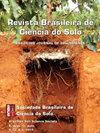Soil macrofauna correlations with soil chemical and physical properties and crop sequences under no-tillage
IF 2
4区 农林科学
Q3 SOIL SCIENCE
引用次数: 0
Abstract
Soil macrofauna is an important indicator of soil quality, as it is sensitive to changes in the environment as a result of soil management, which includes soil chemical and physical properties and the diversity of cultivated species. This study aimed to evaluate the composition and structure of soil macrofauna under a no-tillage system in different crop sequences, with and without crop rotation, over two growing seasons: a rainy summer and a dry winter. The crop sequences were soybean/corn rotation in the summer and corn in the winter; soybean/corn rotation in the summer and sunn hemp in the winter; soybean monoculture in the summer and sunn hemp in the winter; and corn monoculture in the summer and corn monoculture in the winter growing season. The nutrient content of the crop residues left on the soil surface, soil chemical and physical properties, and soil macrofauna were determined. Functional plant groups (grasses or legumes) individually influenced the composition of soil macrofauna more significantly than the effect of crop sequence, with or without rotation, and growing season. Grasses favored an increased density of groups such as Oligochaeta, Isoptera, and Formicidae. In contrast, legumes contributed to the variation in the total density of individuals and Diplura and Coleoptera groups. Furthermore, the influence of functional plant groups (grasses or legumes) on the composition and density of soil macrofauna were related to soil chemical (P and N content) and physical properties (particulate organic carbon and soil moisture), which determined the composition of soil macrofauna groups.免耕条件下土壤大型动物与土壤理化性质及作物序列的相关性
土壤大型动物是土壤质量的重要指标,因为它对土壤管理导致的环境变化很敏感,包括土壤化学和物理性质以及栽培物种的多样性。研究了不同作物轮作和不轮作的免耕制度下,夏季多雨和冬季干燥两个生长季节土壤大型动物的组成和结构。作物序列为夏季大豆/玉米轮作,冬季玉米轮作;夏季大豆/玉米轮作,冬季麻类轮作;夏季种植大豆单作,冬季种植大麻;以及夏季玉米单作和冬季玉米单作的生长季节。测定了作物残余物在土壤表面的养分含量、土壤理化性质和土壤大型动物。功能植物类群(禾草或豆科植物)对土壤大型动物组成的影响比作物序列(轮作或不轮作)和生长季节的影响更显著。草支持组织如寡毛纲的密度增加,等翅目,蚁科。相比之下,豆科植物对总个体密度和双翅目、鞘翅目类群的变化有贡献。此外,功能植物类群(禾草或豆科植物)对土壤大型动物类群组成和密度的影响与土壤化学性质(P和N含量)和物理性质(颗粒有机碳和土壤水分)有关,它们决定了土壤大型动物类群的组成。
本文章由计算机程序翻译,如有差异,请以英文原文为准。
求助全文
约1分钟内获得全文
求助全文
来源期刊

Revista Brasileira De Ciencia Do Solo
农林科学-土壤科学
CiteScore
3.00
自引率
11.80%
发文量
32
审稿时长
9-24 weeks
期刊介绍:
The Revista Brasileira de Ciência do Solo is a scientific journal published by the Brazilian Society for Soil Science (SBCS), founded in 1947, and is responsible for the propagation of original and inedited technical-scientific work of interest for Soil Science.
Contributions must not have been previously published or submit to other periodicals, with the only exception of articles presented in summarized form at professional meetings. Literature reviews are accepted when solicited by the Editorial Board.
 求助内容:
求助内容: 应助结果提醒方式:
应助结果提醒方式:


